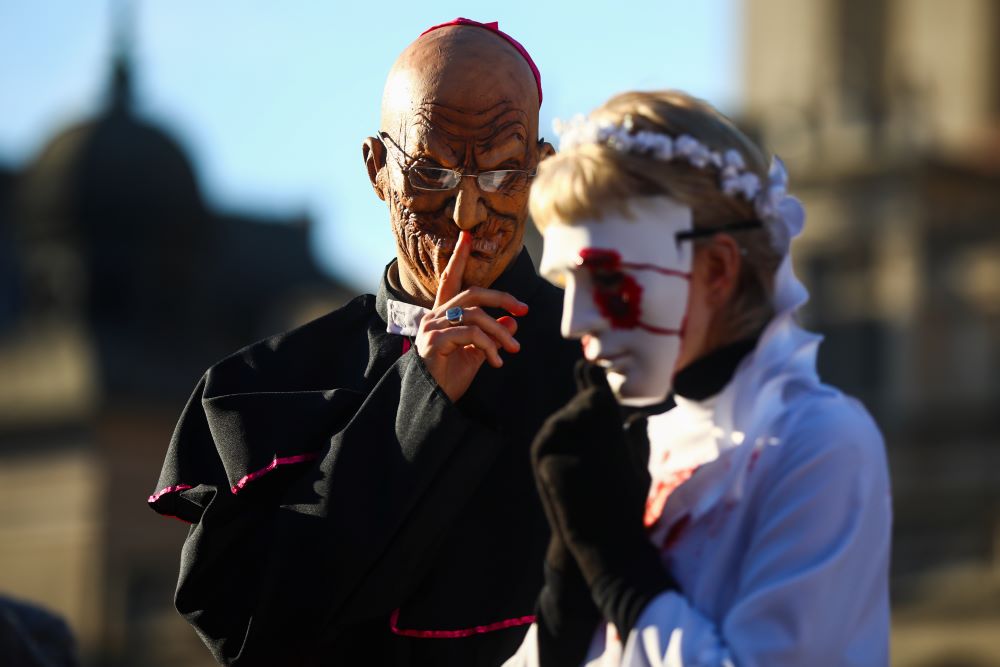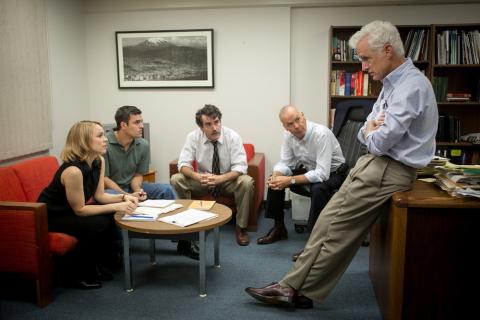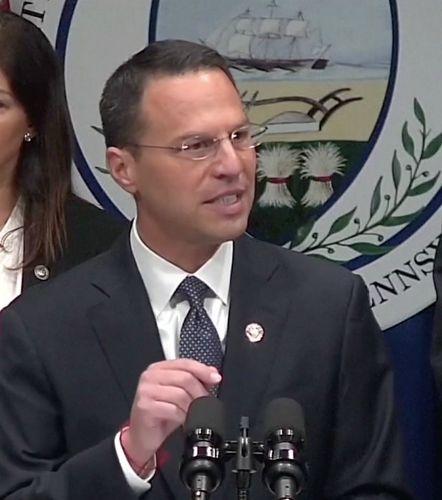
Activists dressed as clergymen and their victims protest the institutional church's protection of sex offenders in Krakow, Poland on Dec. 6, 2020. (ZUMA Press/NurPhoto/Beata Zawrze)
In the United States, the terrible truth that Catholic clergy have sexually violated children has been known publicly now for at least 36 years. For this truth-telling, we are indebted to journalists such as Jason Berry. In stark and unsparing detail he documented in May 1985, writing for the Times of Acadiana (and NCR), the predations of admitted serial pedophile Fr. Gilbert Gauthe in the Diocese of Lafayette, Louisiana.
Over the decades others followed Berry's groundbreaking truth-telling, often against and despite enormous pressure to remain silent. Led by many courageous survivors and their families, of notable mention are the Survivors Network of those Abused by Priests (SNAP), Bishop Accountability, the Boston Phoenix, The Boston Globe, The New York Times and several state attorneys general.
In January 2019, ProPublica published an interactive national directory of credibly accused clergy drawing on the published disclosures of dioceses and religious orders.
The important efforts of these entities and people notwithstanding, they are all limited by the reality that they only know what they know. They don't know what they don't know. The full width and breadth of the story is yet to be told and is held by the archdioceses, dioceses, eparchies and religious orders.

Rachel McAdams, Mark Ruffalo, Brian d'Arcy James, Michael Keaton and John Slattery star in a scene from the movie "Spotlight," which chronicles the Boston Globe's uncovering of the clergy sex abuse scandal in the Archdiocese of Boston in 2002. (CNS/Open Road Films)
I am a social worker. As 2002 began 20 years ago, I was just returning from a three-month sabbatical in my role as the director of the Pro-Life Office and Project Rachel for the Archdiocese of Boston. My career with the archdiocese began in 1977 with a position working in protective services for the elderly at Catholic Charities.
In those first days of 2002, I sensed that change was stirring, but I could not have imagined the tsunami of pent-up pain, anger and human suffering that would be unleashed as The Boston Globe's Spotlight Team began reporting about clergy sexual abuse in Boston on Jan. 6, 2002, the Feast of the Epiphany.
I was asked in those early weeks if I would help develop services and an office to respond exclusively to the survivors and their families with support for mental health services and pastoral care. In addition, supportive services were needed for parish staff and communities whose pastors were being removed because of credible complaints of clergy sexual abuse.
The chancery phone lines were on fire with calls urgently requesting services for survivors and their families. By the end of May 2002, mental health hospitalizations and addiction rehabilitation referrals had become the daily work of a now small but determined team of social workers relocated to a secular office space off the chancery property. In addition, an outreach to families of survivors was initiated — led by a retired nurse and mother of two sons who had been sexually abused by their parish priest.
The numbers of people coming forward were shocking and the level of distress and trauma searing. We met in coffee shops, in libraries, in jails, in hospitals, in public parks, in courtrooms, in the offices of therapists, in rehab facilities, in cars, in churches, in homes and over phone lines burning up with shame and an unrelenting torrent of pain.
The singular questions from the very first meetings with survivors were repeated over and over again. "Was I the only one?" "How many others?" "When did the church know?" The answers were not readily available, nor accessible, nor easily forthcoming. The fear was palpable.

Pennsylvania Attorney General Josh Shapiro speaks during an Aug. 14, 2018, news conference (CNS/Reuters)
Pursuing the truth to honestly respond to the queries of survivors and their families became a baseline for authentic pastoral response, a meaningful path to justice and healing. It was a mantra that in order to restore trust we must act in a trustworthy manner and tell the truth no matter how terrible the truth. Canon lawyers seemed to speak another language and the headwinds of canon law were carried on another mantra: "But it's not a canonical crime."
On Sept. 8, 2003, the Archdiocese of Boston agreed to a settlement of $85 million with almost 550 survivors. At the time, it was the largest such settlement in the history of the U.S. Catholic Church. In April 2008, when five survivors from Boston met with Pope Benedict XVI, a hand-crafted book with the first names of 1,476 survivors was presented to him.
Despite all that has happened over 20 years, those poignant questions from survivors and their families continue to hang in the air still not fully answered. Transparency, accountability, listening and simply telling the truth remain the foundation of any hope for restored trust and healing.
In August 2018, following the twin disasters of the revelations of former Cardinal Theodore McCarrick's sordid history of sexual abuse of both children and vulnerable adults and the release of the Pennsylvania grand jury report, Pope Francis published a Letter to the People of God that coincided with his trip to Ireland for the World Meeting of Families. Francis' words cut to the heart of the matter with a stunningly bold statement of accountability:
With shame and repentance, we acknowledge as an ecclesial community that we were not where we should have been, that we did not act in a timely manner, realizing the magnitude and the gravity of the damage done to so many lives. We showed no care for the little ones; we abandoned them.
Yet, even with Francis' words acknowledging the failure of the church to act in a timely manner, a lack of urgency and decisive action continues to plague any real effort at reform. The single most important action that the bishops of the United States and the religious orders could do to demonstrate their professed resolve to protect and heal is a radical truth telling.
Then-Cardinal Theodore McCarrick waves to fellow bishops as he attends a prayer service with Pope Francis and more than 300 U.S. bishops at the Cathedral of St. Matthew the Apostle in Washington Sept. 23, 2015. (CNS/The Washington Post pool/Jonathan Newton)
Despite some dioceses and religious orders moving forward to publish disclosures, rather than finally shedding light, this exercise has been a muddled mess. The downward spiral is now a full-blown crisis of credibility. With no agreed upon central operating principles and benchmarks for disclosure, each diocese and religious order has self-determined the definition of credibility and which details about the listed cleric to document and publish.
Some dioceses include religious order and deceased priests and some do not. Some dioceses include the assignment histories of the offending clergy and some do not. Some dioceses include dates of ordination and birth dates and some do not. The current status of canonical investigations and appeals is rarely included.
Within particular religious orders one province may have published a disclosure and other provinces of the same order have not. And some dioceses and religious orders have published nothing and have no plan to publish.
It is also important to note that the precursor to disclosure is an exhaustive file review of all personnel files in every diocese and religious order. Without this labor intensive but necessary examination of all clergy files and records, any disclosure is inherently flawed if not impossible. More importantly without a thorough file review, the risk remains that an offending cleric has remained undetected and continues in ministry.
As the U.S. bishops struggle to put into place mechanisms for the reporting of complaints against bishops under the directives of Francis' 2019 measure Vos Estis Lux Mundi, the chances for success and public confidence in this effort are undercut by the failure to honestly disclose the names of all offending clergy.
The full and unvarnished truth about the history of sexually offending clerics, guided by a commonly agreed upon template for disclosure, is urgently needed to establish a foundation for the future as well as to secure confidence in the pledge of the bishops to zero tolerance. It is past time for the bishops and religious orders to be chastened and humbled by the courageous efforts of so many and to publish a national directory.
On the eve of the 20th anniversary of the Boston Globe's Spotlight series and the cascading revelations that followed, the word "crisis" now rings hollow as it applies to clergy sexual abuse. It is no longer meaningful to refer to clergy sexual abuse as a crisis. As the shame and anger moved from the offending cleric to the systemic cover-up by bishops, we now must face the grim reality that the most profound shame is the ongoing, real-time failure to act in a decisive manner to address the "abandonment of the little ones."
Advertisement
There is a story in the Gospels of Mark, Matthew and Luke that recounts an amazing scene where the four friends of a paralyzed man were desperate to bring him before Jesus with the hope that he would be healed. The room was so crowded that they were unable to enter and apparently those in the crowd were unwilling to open a way.
These four friends decided that the only way was to climb on the roof, remove the roof tiles, hoist their friend up on the stretcher and lower him down through the hole in front of Jesus. What a dramatic and heart-pounding moment it must have been to see that stretcher coming down from the roof. Moved by love for their suffering friend and a sense of urgency, this action was accomplished by four friends who put fear and decorum aside.
Time matters. Thirty-six years and counting is, by any measure of justice, too long. We owe it to the survivors. We owe it to the families of survivors. We owe it to the lay faithful and to the clergy. We owe it before God to whom we profess our love and fidelity to tell the truth.








